![]()
![]()
![]()
Use LEFT and RIGHT arrow keys to navigate between flashcards;
Use UP and DOWN arrow keys to flip the card;
H to show hint;
A reads text to speech;
59 Cards in this Set
- Front
- Back

Campin Merode Alterpiece |
1425
*Achieves realism through surfaces and light *Humanizes the Holy family *Makes visual world more special *Catholic Church is not as close or powerful, so private devotional objects became more common
|
|
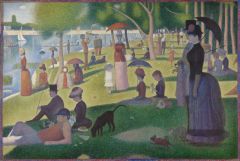
Seurat A Sunday Afternoon on La Grande Jatte |
1884
* Developed pointillism from divisionism |
|

Boucher Madame de Pompadour at her Toilette |
1758
* Shows beautifying ritual tied with identity, status, and politics |
|
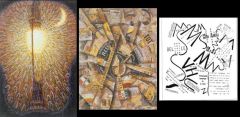
Balla Street Lamp Carra Interventionist Demonstration Marinetti Apres la Marne |
1909
* Finds beauty in speed and the machine
1914
1914
|
|
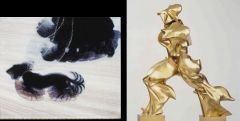
Balla Dynamism of a Dog on a Leash Boccioni Unique Forms of Continuity in Space |
1912
* Turns the dog into a machine that is a blur
1913
|
|
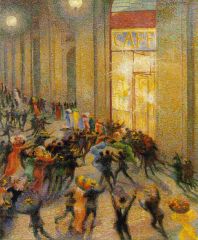
Boccioni A Fight in the Arcade |
1910
* Place of political gathering; electricity |
|
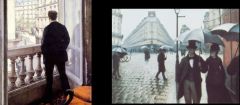
Callibotte Man at a Window Paris Street, a Rainy Day |
1877
* Highlights the idea of observation
1876
|
|
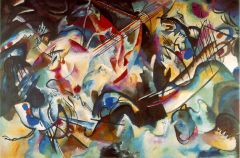
Kandinsky Composition 6 |
1913 * Distinguished sections of shapes and movement |
|

Courbet Peasants of Flagey... Burial at Ornans
|
1849
* They dominate the landscape; not charming or whimsical * Dark groupings of figures |
|

Courbet After Dinner at Ornans The Stonebreakers |
1848
* Considered Avant-Garde Realism
1849
|
|

De Chirico The Rose Tower Dali The Persistence of Memory |
1913
* Images that are dreamlike and nostalgic
1931
|
|
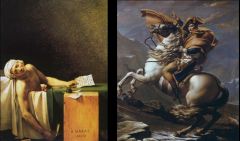
David Death of Marat Napoleon Crossing the Alps
|
1793
* Revolution had begun; he was a journalist
1801
|
|

David Bellisarius Begging for Alms The Oath of the Horatti |
1781
* Pre-revolutionary painter
1785
|
|

David Lictors Bearing to Brutus the Bodies of his Sons Oath of the Tennis Court |
1789
* Emphasizes duty and loyalty over family
1790
|
|
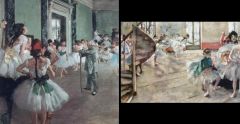
Degas The Dance Class The Dance Rehearsal |
1874
* Vantage point is in the midst of the scene
1873
|
|
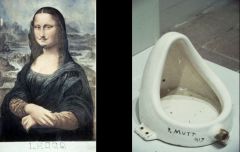
Duchamp L.H.O.O.Q. Fountain |
1919
* Cheap postcard; unoriginal * Breaks down stereotypes of what an artist is
1917
* Found object, created to fit a new purpose |
|
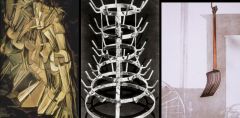
Duchamp Nude Descending Staircase Bottle dryer Advancement of a Broken Arm |
1912
* Submitted to the Armory Show in NY
1914
1913
|
|
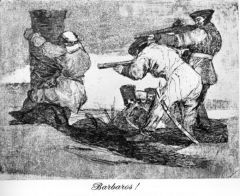
Goya Disasters of War: Barbarians |
1810-1820
* Hybrid set of documentation of war; some are journalistic, some are imagined |
|

Friedrich Abbey in the Oak Grove Wanderer Above a Sea of Mist |
1809
* Former religious structure ad cemetery; some event took place to create desolation
1818
|
|
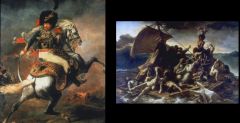
Gericault Charging Chasseur The Raft of Medusa |
1812
* Developed a freer, more dynamic style
1818
|
|
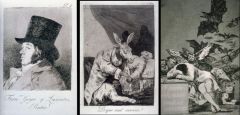
Goya Caprichos |
1799
* Considered human vices and errors a good subject of painting |
|
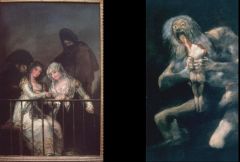
Goya Majas on a Balcony Saturn Devouring his Children |
1810
* Figures are engaging the viewer
1821
|
|
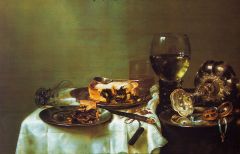
Heda Breakfast Still Life |
1631 * Strong sense of absence; can detect the person that is no longer there |
|

Kruger I Shop, Therefore, I Am Sherman Film Still #6 |
1987
* Appropriation art was starting point for many successful woman artists
1978
|
|
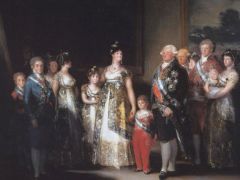
Goya Family of Charles IV |
1800
* Reflects Las Meninas because the artist is placed in the picture as a figure of importance |
|
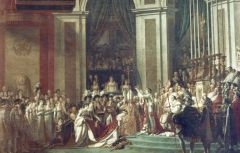
David Le Secre |
1806
* Coronation of Napoleon and Josephine |
|
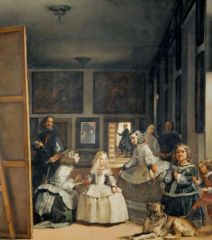
Valazquez Las Meninas |
1656
* Court painter to the Spanish throne and the King's Master of the House |
|
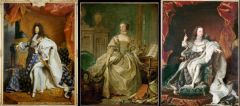
Rigaud Louis XIV Louis XV
Boucher Madame de Pompadour
|
1701, 1715
* All artists are placed into academies under Royal authority
1750
|
|
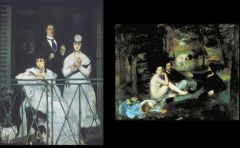
Manet The Balcony Luncheon in the Grass |
1868
* Troubling contemporary subjects
1863
|
|

Manet Olympia A Bar at the Folies Bergere |
1863
* Viewed as a joke, incomplete, offensive
1881
|
|
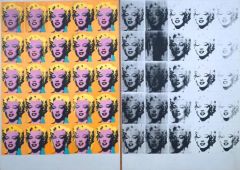
Warhol Marilyn Diptych |
1962
* There is no original Marilyn |
|

Matisse The Joy of Life Kandinsky Composition 7 |
1905
* Has figures, but no narrative
1913
|
|
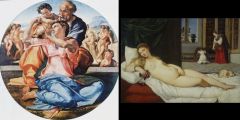
Michelangelo Doni Tondo Titian Venus of Urbino |
1504
1538 |
|
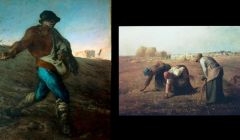
Millet The Sower The Gleaners |
1850
* Simple, rough depiction
1857
|
|
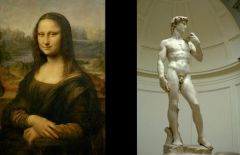
Leonardo da Vinci Mona Lisa Michelangelo David |
1517
1501 |
|

Monet Water Lilies |
1905
* Retreats to home to avoid social conflict and changing times |
|
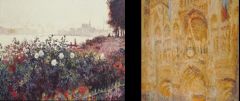
Monet Argenteuil, Bank in Flower Rouen Cathedral at Noon |
1877
* Chaos of quickly brushed color
1894
|
|

Manet Boating Monet Impression Sunrise |
1874
* Impressionistic style with Realism
1872
|
|
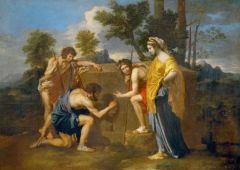
Poussin Et in Arcadia Ego |
1650
* Mythical place with no pain or death |
|
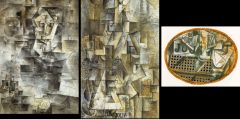
Picasso Portrait of Kahnweiler Ma Jolie Chair Caning |
1910
* New idea of art dealers and their relationship
1910
1912
|
|

Picasso Self Portrait Les Demoiselles d'Avignon Fan, Salt Box, and Melon |
1906
* Deeply cut eyes
1907
1909
|
|
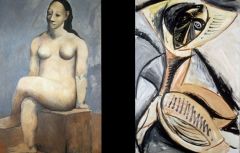
Picasso Seated Nude Nude with Arms Raised |
1907
* Large, blocky, column life * No effort to describe |
|

Pissarro Red Roofs Cezanne Still Life with... |
1877
* No specific subject; focus is color and light
1894
* Interested in color and form |
|
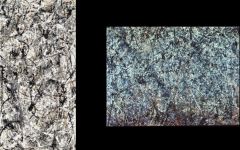
Pollock Cathedral Lavender Mist |
1947
* Controlled pallet between black, white, gray, orange, yellow
1950
|
|

Renior Luncheon of the Boating Party Dancing at the Moulin |
1881
* Favorite topic was leisure
1876
|
|
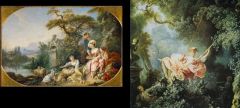
Boucher The Shepherd
Fragonard The Swing |
1737
* More variety of color
1767
|
|
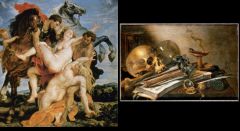
Rubens Rape of the Daughters of Leucipus
Claesz Vanitas |
1618
* Spirited appeal overrides viewer's darker reflections about the abduction
1656
|
|

Pollock Mural |
1943
* Commissioned by Peggy Guiggenheim |
|
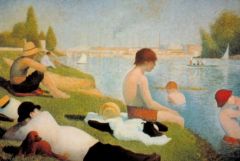
Seurat Bathers at Asnieres |
1884
* Impressionistic because of leisure, social mixing, and incomplete surfaces |
|
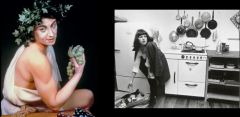
Sherman Untitled (Caravaggio) Untitled Film Still |
1978, 1979
* Imitates famous works of art |
|

Monet Bridge at Argenteuil |
1874
* Location of many people who have relocated into the cities |
|
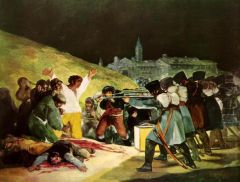
Goya Third of May, 1808 |
1814
* Commissioned by Bonaparte to honor uprising |
|
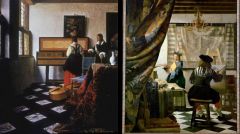
Vermeer The Music Lesson The Art of Painting |
1665
* Figures are placed far away
1666
|
|
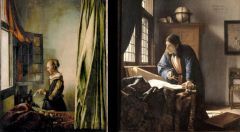
Vermeer Woman Reading a Letter The Geographer |
1659
* Obscured only symbols of what the letter really is
1668
|
|
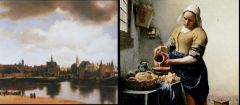
Vermeer View of Delft The Milkmaid |
1660
* Painting of town; seems slightly off
1658
|
|

Lin Vietnam Memorial |
1982
* Captures the idea of the screen |
|
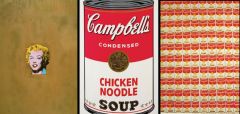
Warhol Gold Marilyn Campbell's Soup |
1962
* Mocks how celebrities are idolized/worshiped |
|

Whiteread Ghost Vienna Holocaust Memorial |
1990
* Installation piece created from molds of spaces
2000
|
|
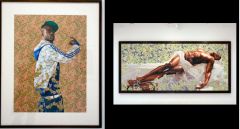
Wiley AfterA Bacchante After Sir Joshua Reynolds Sleep
|
2007
* Black male subjects shown with grand gestures |

